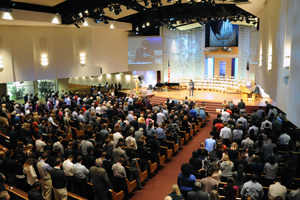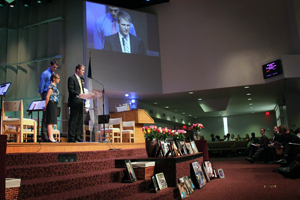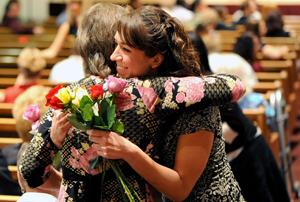
My last patient took longer than anticipated, so I was late as I headed across campus several Thursdays ago. Slipping into the back of the University Church, I could see the program was underway. Some of our students had already met their special guests, showing them about campus and helping them find seats in the sanctuary. The last 10 or 15 rows had been roped off, so the front two thirds of the church were completely full. I lifted the rope and sat down behind the last row of guests. I could tell that most of those present had never been in our church before. They were sitting in family groups and had come to say farewell once again.
 This was the annual Memorial Service of our “Bodies for Science” program. Over the last three quarters, our students and their instructors had been carefully dissecting and studying the loved ones of these family members. Students from medicine, dentistry, occupational and physical therapy, and nurse anesthesia programs were talking about the “teacher” with whom they had become intimately acquainted as they worked their way through his or her muscles, nerves, vessels, and organs. They had taken careful note of the normal and unusual, the scars left from life, the organs repaired, and the disease processes that had finally claimed each life. Some of our students were now speaking of the impact on their own lives of these most valued “teachers.”
This was the annual Memorial Service of our “Bodies for Science” program. Over the last three quarters, our students and their instructors had been carefully dissecting and studying the loved ones of these family members. Students from medicine, dentistry, occupational and physical therapy, and nurse anesthesia programs were talking about the “teacher” with whom they had become intimately acquainted as they worked their way through his or her muscles, nerves, vessels, and organs. They had taken careful note of the normal and unusual, the scars left from life, the organs repaired, and the disease processes that had finally claimed each life. Some of our students were now speaking of the impact on their own lives of these most valued “teachers.”
The printed program listed each person only by his or her date of death and occupation. From homemaker to mechanic, physician to teacher, pilot to cashier, you could see the vast diversity of those who had voluntarily indicated they wanted to donate their bodies for this last act of service to humanity. I could see the families of the deceased look quickly through the 170 dates and careers listed in the program and nod in agreement as they recognized their loved one on the list. Tears came freely as they remembered once more the one they had lost—that loss now balanced with a renewed appreciation for the gift their loved ones had given to our students and medical science.
Organized by our anatomy professor, Dr. Bertha Escobar-Poni, this was the 19th annual Memorial Service at Loma Linda. We have nearly 5,000 people who have registered to donate their bodies to this program when they die. Each year, some 170 bodies are delivered to our anatomy lab after personal funeral ceremonies, where they are embalmed and used during the school year. When the dissection is completed, the bodies are cremated and the ashes can be returned to the family. This service commemorates a selfless act of giving, with a thank you to those families who participated in the gift.
 My mind went back six or seven years when we were making decisions about the Centennial Complex. A number of medical schools were shifting from dissecting real cadavers to having “virtual” anatomy labs—computers loaded with programs to enable you to “dissect” through the body’s systems on the screen. Faster, easier, and certainly cheaper, these programs probably gave a student the ability to pass anatomy exams just as well as dissecting real bodies. But there is something very sacred about working on a real person—one who had walked the path of life, loved others, struggled with many issues, and finally offered his or her body for the benefit of medical science. Our students certainly caught that difference as they eloquently thanked the family members of their “teacher” for what that person had meant personally to them. I was thankful we had made the decision to build a major new anatomy laboratory in the Centennial Complex. I was particularly thankful to Dr. Bill and Rose Swatek, whose gift had provided this laboratory.
My mind went back six or seven years when we were making decisions about the Centennial Complex. A number of medical schools were shifting from dissecting real cadavers to having “virtual” anatomy labs—computers loaded with programs to enable you to “dissect” through the body’s systems on the screen. Faster, easier, and certainly cheaper, these programs probably gave a student the ability to pass anatomy exams just as well as dissecting real bodies. But there is something very sacred about working on a real person—one who had walked the path of life, loved others, struggled with many issues, and finally offered his or her body for the benefit of medical science. Our students certainly caught that difference as they eloquently thanked the family members of their “teacher” for what that person had meant personally to them. I was thankful we had made the decision to build a major new anatomy laboratory in the Centennial Complex. I was particularly thankful to Dr. Bill and Rose Swatek, whose gift had provided this laboratory.

As the first students completed their tributes, others came forward to play “It Is Well With My Soul,” recognizing God’s guidance in life. Then more students shared poems, humorous incidents, and passionate comments about how this experience had changed their understanding of life and their appreciation for the marvels of the human body. This was followed by 21 students each saying “thank you” in their native tongue, including some languages I had never heard. As they finished speaking, “We Thank You” was played on the organ while students gave rose buds to the family members, sharing hugs and tears.
As the program was closing, the audience stood for the playing of taps and a moment of silence. What a testimony to those present as they sensed that the benefits of this “anatomy lesson” would be carried in the minds and hearts of these young professionals to many countries and patients for years to come. After a final orchestral and vocal rendition of “Amazing Grace” by the students, followed by closing prayer, we were each left with a profound feeling of the value of life and the sacredness of the healing professions in serving others. I exited quietly through a side door, dabbing my own eyes.
Sincerely,
Richard Hart, MD, DrPH
President
Loma Linda University Health
Office of the President, Loma Linda University, Loma Linda, CA 92350
Copyright © 2013 by Loma Linda University



